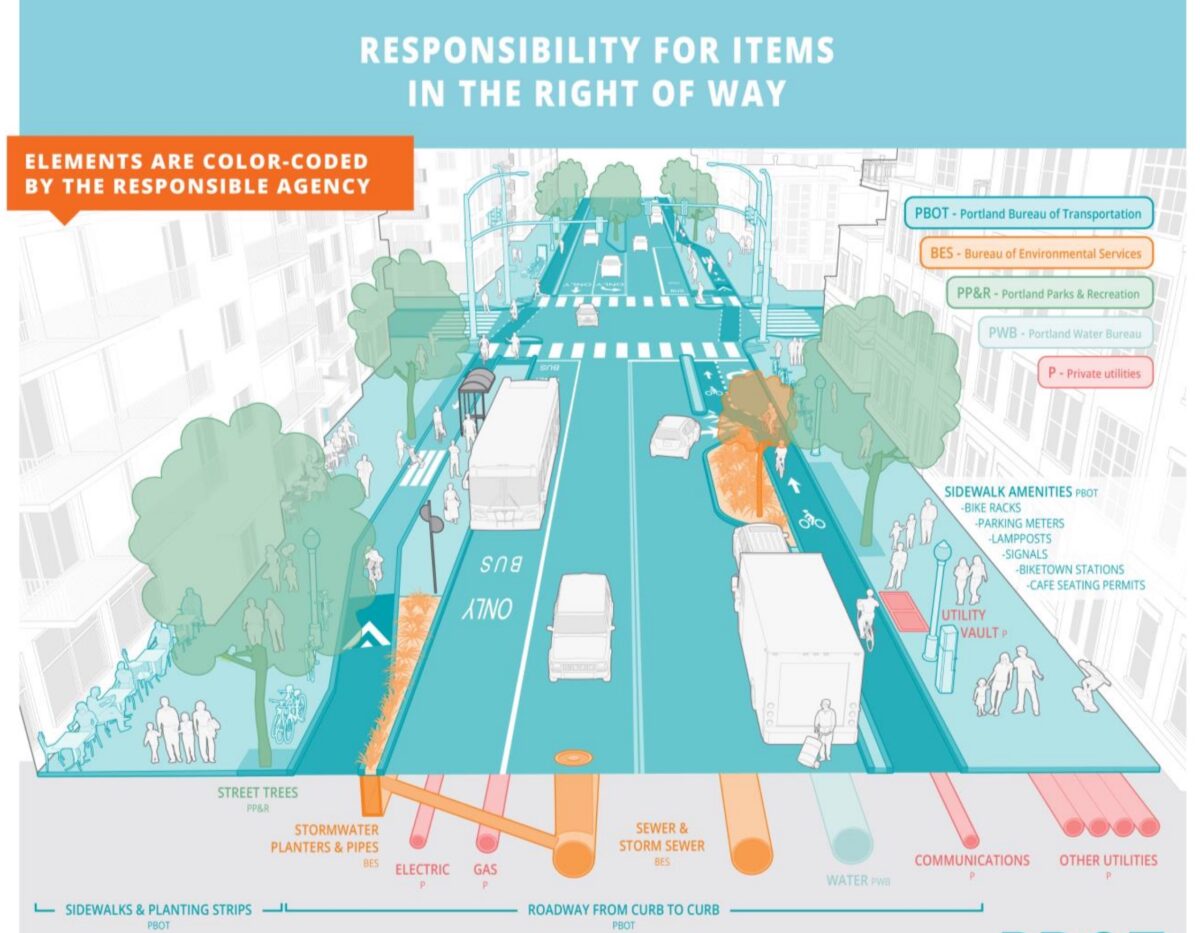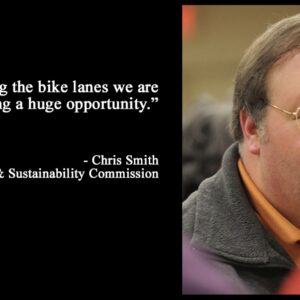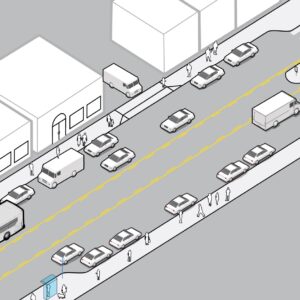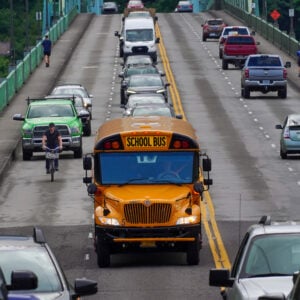
(Source: PBOT/Streets 2035)
The City of Portland’s Streets 2035 initiative might be the most consequential planning process you’ve never heard of.
Reduce situations that require individual interpretation and inter-bureau negotiation.
— From a Streets 2035 presentation
Based on the simple premise that our population is growing but our streets are not, Streets 2035 is the Portland Bureau of Transportation effort to establish a decision-making framework for how right-of-way is allocated. Or in their words, the project is an attempt at, “identifying a right-of-way allocation framework that moves streets forward to achieve citywide objectives, minimizes the need for an exception process, and helps bureau staff achieve a predictable and transparent process for themselves and external stakeholders.”
Think of the (sometimes) competing goals of pedestrian safety and a complete bike network. The former might call for a curb extension that makes the latter harder to build. Or consider, like we’ve seen with the Hawthorne Pave & Paint debate, how the need for automobile and transit access impacts citywide goals for protected bike lanes.
Advertisement
For such a hot-button topic as who-gets-what, it’s surprising this initiative has flown so far under the radar.
Well over two years old already, PBOT has not taken the plan to the public and, based on the official website, doesn’t appear like it plans to. This effort is likely to influence cross-section designs and what gets built. More people should be aware of it.
PBOT is leading Streets 2035 because they are (by law) in charge of managing right-of-way, but five other bureaus are closely implicated. Portland Parks & Recreation, the Water Bureau, the Bureau of Environmental Services, the Bureau of Development Services, and the Bureau of Planning & Sustainability all play a role because they own and manage infrastructure that lives in the right-of-way. The “2035” part of the name stems from fact that in many ways this is an addendum to Portland’s 2035 Comprehensive Plan.
There are four main objectives for Streets 2035 (as per a PBOT presentation):
…to develop context-sensitive decision-making framework that guides space allocation in the right-of-way to:
- Better achieve citywide and individual bureau goals
- Reduce situations that require individual interpretation and inter-bureau negotiation
- Increase certainty and clarity for people wishing to develop in and adjacent to the ROW
- Create a consistent starting point for capital projects design development
That second bullet point really stands out to me. In addition to giving planners and developers more clarity on what goes where, Streets 2035 appears to be an attempt by PBOT to deflect blame for unpopular and/or controversial decisions. When a project manager tells a group of advocates they cannot fit a bike lane in a particular design, for instance, they’ll be able to hold up the Streets 2035 guidelines and point to any number of reasons that space for cycling simply isn’t feasible in a particular context. (We got a taste of this when PBOT decided against bike lanes on Hawthorne, despite them being called for in multiple planning documents and aligning with many city goals and values.)
In a summary of their Phase 1 work, PBOT separated out the right-of-way into three distinct zones (above): “pedestrian”, “curb/flex” and “travelway”. The pedestrian zone is where people walk and street trees grow. The curb/flex zone is where bike lanes are installed, people park cars, and (increasingly) where outdoor diners eat. The “travelway,” according to PBOT is where “cars, buses and streetcar, and trucks drive.” It’s a bit of a red flag to me whenever bicycles are pushed into the margin and not on the same level as cars, so this is something I plan to watch closely as the plan’s recommendations are implemented.
As you can see, the implications of Streets 2035 to bicycling could be profound — especially in a city where cycling isn’t strongly championed by anyone in City Hall or among PBOT top brass.
PBOT presented an update on Streets 2035 to their Bicycle Advisory Committee in October 2019. Members voiced several concerns. One person worried the process didn’t center equity and justice its approach. Another person wondered how an influx of leaves from more street trees (if that was an outcome) would impact the cleanliness of bicycle and mobility device users. Another BAC member worried that the process was too technical and didn’t incorporate values like social equity, air quality and Vision Zero into its framework. Several people said the entire project felt too driving-centric and that they’d like to see more carfree typologies included.
According to the Streets 2035 website, the project is nearing completion. Now would be a good time to learn more about it. You can share feedback and ask questions of PBOT Project Manager Matt Berkow via Streets2035@portlandoregon.gov.
— Jonathan Maus: (503) 706-8804, @jonathan_maus on Twitter and jonathan@bikeportland.org
— Get our headlines delivered to your inbox.
— Support this independent community media outlet with a one-time contribution or monthly subscription.









Thanks for reading.
BikePortland has served this community with independent community journalism since 2005. We rely on subscriptions from readers like you to survive. Your financial support is vital in keeping this valuable resource alive and well.
Please subscribe today to strengthen and expand our work.
Jonathan, thanks for “yellow flagging” this topic and I share your concern about how the bike movement space is being categorized. [I am hold off until we learn more, if there is some sorta unmentioned strategy in their thinking.] I hope they do a follow up schematic that has overplayed some of the private easement / permit spaces and who is responsible for “maintanence”…outdoor parklets (cafe owner for sweeping and accessory structure), car share pod (signage), bike share (dock, bikes and signage etc.), USPS/ FedEx/ UPS (package box)…etc.
I welcome “Streets 2035,” I think it will bring clarity and transparency to what has been the murky intersection between development and transportation.
I’ve had my eyeball on the project for a couple of years, and was informally told that it was mainly an engineering effort looking at what was technically possible to build on various streets. That might be why there hasn’t been the usual public rollout and input.
Go to the third page, “Existing Conditions in the Right-of-Way,” of the Phase 1 Summary Report. There you will see a map of “Pattern Areas” in the city grouped by ROW width.
https://www.portland.gov/sites/default/files/2021/streets-2035_phase-1-summary_03.05.21.pdf.
The Central City, Eastern Neighborhoods and Inner Neighborhoods have decent ROW widths, especially East Portland.
Where things get really constrained are in the Western Neighborhoods, where the ROW is typically between 22 and 24 ft. What’s been happening in SW Portland is that infill and new development can’t comply with city ordinance requiring transportation improvements, like sidewalks and bike lanes. So the city waives, or waters-down, these requirements through an “Alternative Review” process which is a closed-door deal brokered between the developer and the city. The public is eventually presented with the done deal which it can oppose before a Hearings Officer, appeal before City Council or take to the state-level Land Use Board of Appeals. It is an aggravating, expensive and inefficient process for everyone involved.
SW Neighborhood Associations do this regularly.
My understanding is that Streets 2035 will make clear to all parties what the city expects on these narrow neighborhood collectors, rather than having them litigated piecemeal, on the fly, development by development.
But I do think it will be a rip-the-bandaid-off moment when the city accepts accountability for these decisions. I think it is a good thing.
The questions then become 1), how will the city make streets safe for all users on roads too narrow for bicycle and pedestrian facilities? Lower the speed limit? 2) how much car-dependent development will the city continue to allow in neighborhoods lacking active transportation facilities or adequate public transportation?
Thanks for this Lisa. Should have had you write about it!
You still can!
No street is too narrow for bike lanes and sidewalks. If it’s a residential street, it should be significantly traffic-calmed, and if it’s an arterial (Belmont, SE 20th) either the parking lanes should become bike lanes or the street should be made one-way to accommodate bike lanes. Or it becomes car-free (Alberta, Mississippi). This is the Dutch way—bikes and peds come first. Cars get any leftover space. Not the other way around.
It’s fun to look at Dutch street transformations on streetview. Here’s one where people in Portland might have said the street is too narrow for bike lanes:
Before: https://ibb.co/Vg91NNK
After: https://ibb.co/tsH0dx2
I don’t think bikes should come first at all. People who bike should be a distant second to Peds(+transit) when it comes to transportation priorities.
PS: Jun 14 is lane striping day! Watching people in sport utility cages (SUC) freak out over the loss of their lanes is going to be fun.
I’m with you on getting rid of parking on “arterial” streets that are otherwise too narrow, but I think in some cases wider sidewalks are what should take precedence over bike lanes, because some of the sidewalks on those arterials are dangerously narrow for the amount of people who (non-pandemic) traverse/hang out on them.
Can you provide an example of an arterial street you think should have wider sidewalks at the expense of bike lanes?
Zach Katz:
Hawthorne too (but PBOT still prioritizes deeply-subsidized cage storage over children and families walking/rolling as pedestrians in their neighborhood).
PS: As long as a cyclist acknowledges that bikes are guests, there is absolutely nothing wrong with riding on a sidewalk or in a pedestrian area.
PPS: I am a huge fan of pedestrian-cycling and believe that this style of cycling is enormously more important for increasing mode share than the vehicular cycling that many bike advocates/enthusiasts favor.
Hi Zack, I agree, anything can be engineered for a price. Adding a mile of bike and pedestrian lanes on SW Capitol Highway is budgeted at $27,500,000. That price tag is why options like advisory shoulders and fully adopting Portland ordinance 188774 (which lowers the speed limit on city streets to five mph lower than the statutory limit) have potential to improve safety in SW.
Advisory shoulders:
https://bikeportland.org/2021/04/01/advisory-shoulders-could-unlock-potential-of-streets-in-southwest-portland-329501
Thanks Lisa for pointing all of this out. To clarify, I don’t believe that the Alternative Review Process noted below is a land use decision or action in itself.
If we are talking about the same process, its noted here and the process is appealable to the Public Works Board.
If the Alternative Review Process is completed along with a land use decision, it would be an interesting question to ask if it then becomes part of the land use decision that is appealable–that may be a land use attorney’s realm.
Hi Rachel,
Thank you for your comment. The complete name of the Alternative Review I’m talking about is, indeed, the Public Works Alternative Review.
To disclose my experience with this, I was recently deeply involved in a land use case and organized presentations before the Hearings Officer and the City Council. We took the appeal all the way to LUBA and lost.
The Public Works Alternative Review does become part of the land use decision, and we argued that the city and developer used the PWAR to diminish down to nothing Portland’s ordinances requiring frontage improvements.
The way I think of land use and transportation is this: you can require a developer to ice a cake, but the city cannot make the developer prepare and bake the cake. SW Portland, transportation-wise, is an unbaked cake. So requirements like sidewalks and bike lanes get waived through alternative review.
It takes a while mucking around in the weeds to figure this out. You know that nice PBOT graphic showing how sidewalk coverage correlates with annexation into the city? What it doesn’t tell you is that unstated Portland land use policy exacerbates the problem by continuing to allow development without sidewalks in these areas.
That’s why I think that Streets 2035 might be a moment of reckoning when the city has to admit that it doesn’t have the infrastructure to support the transportation needs of more growth, at least in SW. I haven’t verified this, so check it yourself, but someone recently told me that the new subdivision at Alpenrose won’t be required to have sidewalks internally, or on the periphery.
from observing a few of these:
1. public input MAY be passed on to review personnel, but not necessarily taken into consideration.
2. only the APPLICANT may appeal an alt review decision.
3. if you feel the alt review plan is inadequate you can file an appeal against the WHOLE project and specify deficiency of alt review decision.
public input in the alt rev process leading to a better output might have stopped a land use appeal from being filed in a number of cases, and saved time and money on all sides.
moot now – council changed code from ‘all conditions in code must be met’ to ‘conditions mostly need to be met, and we’ll decide what’s good enough.’
I am very worried about this. The implications if PBOT gets it wrong could be huge. A policy change as big as this one should be done in the open. I do not trust all these bureaus to come up with the best solution on their own. There is a reason advocates exist, to push government to do better. By keeping such a big change secretive there is no way for advocates to push bureaucrats for the best possible plan.
With all due respect, I would be far more worried about the sharp drop in cycling mode share that is, IMO, partly the result of the pro-housing-speculation politics pushed by cycling advocates (Hi PfE/P:NW).
Who knew that protecting the ability of landlords to economically evict those mostly likely to use alternatives to cages would lead to a drop in transit and bike use???
A person who supports housing speculation is not a cycling advocate, they are a housing speculation advocate.
I very much agree but, unfortunately, the venn diagram of these two forms of advocacy overlaps substantially in Portland.
Some musicians smoke, if I play guitar will I get emphysema?
If I take up oil painting am I responsible for the whole Cheney thing?
Venn diagrams show s correlation.
That’s quite the evidence-free hot take there, Soren.
The drop in low-income “bike to work commuters” as a percent of all bike commuters and the decrease in bike mode share in inner Portland neighborhoods kinda speaks for itself. I linked to some of this data here a few weeks ago but you and Michael are quite familiar with IPUMS so have at it:
https://usa.ipums.org/usa/
The hot take was blaming Portland: Neighbors Welcome for this.
Nice strawperson, Iain.
Please tell me that you are not denying that PfE/P:NW have pushed for deregulation of speculative (market) housing?
I am absolutely denying that. It’s really incredible the idea that you have in your head of housing advocates.
IMO, the Streets 2035 is one the most explicit and frank discussions I’ve seen of the way street engineers with PBOT, BES, PWB, Parks, and private utilities think versus the way city planners work with the public. Moving curbs is very expensive, sometimes prohibitively so, because you also have to move the storm sewers, sewer intakes, grates, bulb-outs, sumps (in East Portland), and sometimes the household sewers too, plus any unrelated utility conduits that happen to be nearby, and of course sidewalk vaults and garbage systems under the sidewalks in the downtown core. These are among the items engineers think about even as planners and us community activists keep pushing to adjust the street width as if money is no object and that social equity trumps all, and why your local city engineer is invariably referred to by developers and activists alike as “Dr. No”.
I’m surprised there’s no discussion of wireless communications and cell towers.
1) PBOT’s announcement about Hawthorne just prior to meeting with the BAC; 2) Hardesty’s claim of being unaware PBOT even has a bike plan; 3) Streets 2035 declaration that bikes belong in the loading/parking zone, out of the way of actual transportation.
No wonder cycling mode share is falling. Biking is so over in Portland.
[If I hadn’t wanted to keep my list policy focused, I could have added some policy-adjacent items such as: Unchecked driving insanity and its consequent death toll; abandoned and unusable infrastructure such as the I-205 path; multiple open air stolen bike emporiums; the city’s apparent buy-in to the odious formula that bikes = white people = bad, which we’ve seen play out in a number of contexts recently.]
Agreed. Since I can’t afford a car and can afford a bike (which as we know suddenly makes me part of “the bicycling community”), the “flex zone” is in fact where I travel. Although perhaps important to note that bicycles would be legal in all three of these zones (sidewalks outside of the downtown core).
And describing the sidewalk as the “pedestrian zone” “where people walk” excludes people using mobility devices who aren’t walking.
“Portland Parks & Recreation, the Water Bureau, the Bureau of Environmental Services, the Bureau of Development Services, and the Bureau of Planning & Sustainability all play a role because they own and manage infrastructure that lives in the right-of-way.”
The Bureau of Planning and Sustainability does not own or manage any infrastructure. Makes one wonder if that is a small source of the tension between what can be dreamed up vs what can be built?
I perceive this more as an overt consent to the way the bike lanes are currently used. From my observations, bike lanes in busy urban areas are constantly invaded by drop off / pickup traffic. Such as Uber and Lyft.
I remember sitting in a BikeLoudPDX meeting many years ago and finding zero support for my conviction that TNCs will negatively impact cycling and transit mode share. It’s so very ironic that some of the strongest support for TNCs in Portland comes from car-“free/light” cycling enthusiasts.
Uber, Lyft, Door Dash, etc should be limited to designated drop points _paid for by their franchise fees_ however much that costs. I name Door Dash because I’m tired of their remarkably cynical U tube commercials. (Conventionally attractive white person at leisure in nice apartment tells us how much money they make with an app based driving gig wtf)
People driving motor vehicles let me know in various ways that they feel bikes are toys and now we have this weirdly veiled-but-explicit thing from the city.
Car storage space should come out of the motor vehicle slice of the pie.
almost a decade ago, two major road repairs in my area removed pedestrian access and sprinkled utility cabinets in what was left. workers shruggged. 5 or 6 years ago i asked a pbot employee why they didn’t have a master plan for the road as it developed. he said ‘good idea; never gonna happen.’ and recently i watched pbot redo a whole intersection, roadway to ramps… and then, 6 months later, water cut the new concrete to replace a hydrant valve. as the replacement was planned some time before, i asked why the depts didn’t co-ordinate. more shrugs.
portland’s departments are siloed to hell and back, internally and externally. some seem to work at cross-purposes, or actively hate each other and go out of their way to impede (confirmed by one dept. supervisor: “my boss hates their boss”). if this plan eliminates that crap by making templates that all departments must work to, i’d be all for it. but with no public input, the plan is more likely going to end up as ‘what makes the job easier and cheaper for all departments’ rather than ‘best results for all users.’
case in point:
“Throughout this effort, PBOT will consult with other bureaus and partner agencies whose plans, policies and design standards influence the ROW; and private stakeholders such as utility companies, developers, and others whose operations rely on the ROW”
no mention of end users.
Thanks for daylighting this Jonathan! In PBOT/Matt Berkow’s own words, Streets 2035 isn’t creating any new policy and so doesn’t need to go through any public process. Really! He actually said that! Watch the 30 min presentation he made at the May 25 Planning and Sustainability Commission meeting here: https://youtu.be/HcqDIMkqWdQ?list=PLfrETCbg3gsjbN6XejJe_CS1tlRcX87k-&t=5020
I am flabbergasted by this notion! I think it highlights the shear arrogance of PBOT and the utility bureaus. Streets 2035 has huge implications for how we deal with the over-appropriated right-of-way in Portland, alleviate or mitigate for traffic violence, and adapt to the climate crisis (with re-greening via street tree plantings). And we are left with a process that is dominated by PBOT plus a handful of engineers with BES, and the Water Bureau.
BikePortland readers: Please give PBOT an earful on this. But don’t stop there. Contact City Council because I think things will only change when the electeds do some traffic calming on the dangerous, high-speed arterial that is the Streets 2035 process.
-Ted
The lack of public involvement in this project is a new low for the city. There have been (and apparently will be) zero public meetings about this. Yes, Matt has presented at the Bicycle advisory committee, the Pedestrian committee, and Forestry Commission. Yes, and at the Development Review Advisory Committee (DRAC). So members of those committees could comment. Supposedly these events allowed public comment on the plan, too. But at the BAC, PAC, and Forestry, public comment is limited to the beginning and end of the meeting, so there’s usually no way to ask questions of Matt, and if his presentation is in the middle of the meeting, he might not even be present when the questions or comments occur. As far as the DRAC, the meetings do not allow public comments at all.
On the 9th page of the pdf (Titled “4. Evaluation of Street Types”) is what seems to be an assessment of current conditions. The language seems to treat many streets as places where “It can be most difficult to meet all policies within the constraints of the available space”. But the chart is confusing, listing current conditions (curb-to-curb width, e.g.) but also “Modal Priority” which seems to be a listing of policies, since I don’t think that on 42% of Neighborhood Main Streets, bikes are the Modal Priority in current conditions.
A good example of an unclear list is “Street Trees per 200 feet”. I assume they’re talking about on both sides of a street. For 200′ the Urban Forestry tree requirements call for trees every 20′, or about 18 trees per 200′. Yet the graph at right lists averages (?) on Community Corridors of 1.6 trees. The highest listed is Neighborhood Main Streets with 3.7 trees per 200′, a far cry from the 18 trees called for. Yet there’s, so far, no discussion of how this project will address the discrepancy. Will the policies get us any closer?
The “Modal Priority” chart is most puzzling, as I don’t think it’s listing current conditions, but policy aspirations. Is it true that 76% of Community Corridors (like SE 20th) are supposed to give bikes “priority”?